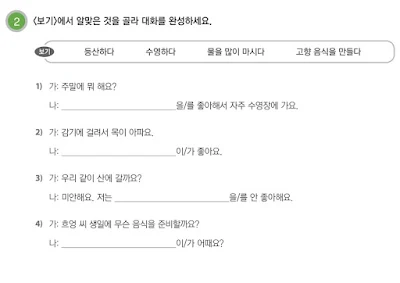KIIP 1 Lesson 16 A/V-아/어서and V-는 것 grammars = ‘because’ and ‘V-ing’ ~expressing reason or converting verb to noun in Korean
1. A/V-아/어서 grammar = ‘because’ ~express reason in Korean
- It is used when the preceding content is the reason for
the following content.
(앞의 내용이 뒤의
내용의 이유가 될 때 사용해요.) =
‘because’ in English
어제 왜 병원에 갔어요? – 배가 아파서 병원에 갔어요.
Why did you go to the
hospital yesterday? - I went to the hospital because my stomach hurt.
그 드라마를 자주 봐요? – 네, 재미있어서 자주 봐요.
Do you watch that drama
often? - Yes, I watch it often because it's fun.
어제는 피곤해서 집에서 쉬었어요.
I was tired yesterday, so I
rested at home.
저는 감기에 걸려서 약을 먹었어요.
I took medicine because I
had a cold.
Tense
Verb/Adjective
ending in vowel + 아서
만나다 (to meet) -> 만나서
보다 (to see) -> 봐서
높다 (high) -> 높아서
아프다 (hurt) -> 아파서
Verb/Adjective
ending in vowel + 아서
먹다 (to eat) -> 먹어서
재미있다 (interesting) -> 재미있어서
감기에 걸리다
(to get a cold) -> 감기에 걸러서
Verb/Adjective
ending in 하다 + 해서
피곤하다 (tired) -> 피곤해서
행복하다 (happy) -> 행복해서
청소하다 (to clean) -> 청소해서
Examples
1. 어느 병원에 가요? – 눈이 아파서 안과에 가요.
Which hospital do you go to? - My eyes
hurt, so I go to the eye doctor.
2. 어느 병원에 가요? – 감기에 걸려서 내과에 가요.
Which hospital do you go to? - I have a
cold, so I go to the internal medicine doctor.
3. 어느 병원에 가요? – 이가 아파서 치과에 가요.
Which hospital do you go to? - My teeth
hurt, so I go to the dentist.
4. 어느 병원에 가요? – 다리가 부러져서 정형외과에
가요.
Which hospital do you go to? - My leg is
broken, so I go to the orthopedic doctor.
2. V-는 것 grammar = V-ing ~converting a verb into a noun to use as a subject
or object
- It is used when converting a verb into a noun to use it
as a subject or object. (동사를 주어나 목적어 등으로 사용하기 위해서 명사로 만들 때 사용해요.)
선생님, 오늘 배가 아파서 학교에 못 가요. 약을 먹었지만 계속 아파요. – 그래요? 그러면 빨리 병원에 가는 것이 좋아요.
Teacher, I can't go to
school today because my stomach hurts. I took medicine, but it still hurts. -
Really? Then it's better to go to the hospital quickly.
잠시드 씨,
노래방에 안 가요?
– 네,
저는 노래 부르는 것을 안 좋아해요.
Mr. Jamshid, don't you go
to karaoke? - No, I don't like singing.
잘 먹는 것이 건강에 좋아요.
Eating well is good for
your health.
Tense
Verb + 는 것 = V-ing
가다 (to go) -> 가는 것
(going)
쉬다 (to rest)-> 쉬는 것
(resting)
먹다 (to eat) -> 먹는 것
(eating)
씻다 (to wash) -> 씻는 것 (washing)
Examples
1. 집에서 푹 쉬는 것이 좋아요.
It's good to rest at home.
2. 병원에 가는 것이 좋아요.
It's good to go to the hospital.
3. 생강차를 마시는 것이 좋아요.
It's good to drink ginger tea.
4. 약을 먹는 것이 좋아요.
It's good to take medicine.
Practices for the A/V-아/어서 grammar
See the example and complete the sentence <보기>를 보고 문장을 완성하세요.
Practices for the V-는 것 grammar
See the example and complete the sentence <보기>를 보고 문장을 완성하세요.
Review KIIP 1 Lesson 15 A/V-네요 and N-보다 grammars = ‘really’ and ‘than’ ~express feeling and comparison in Korean



